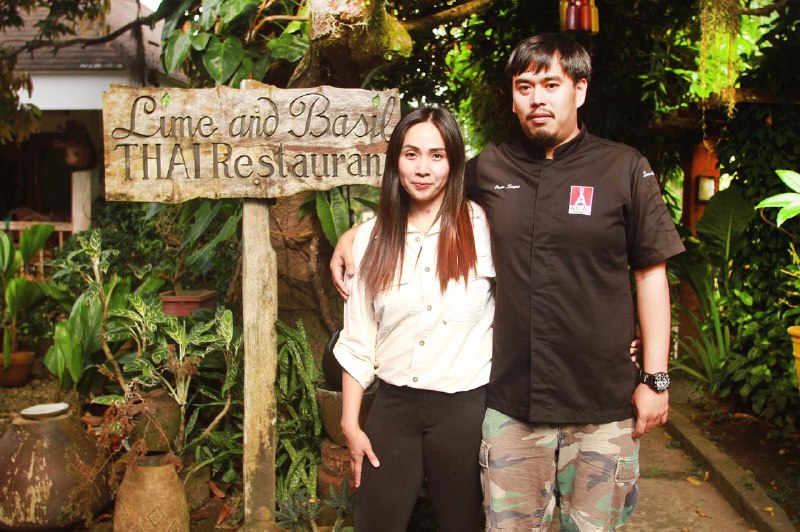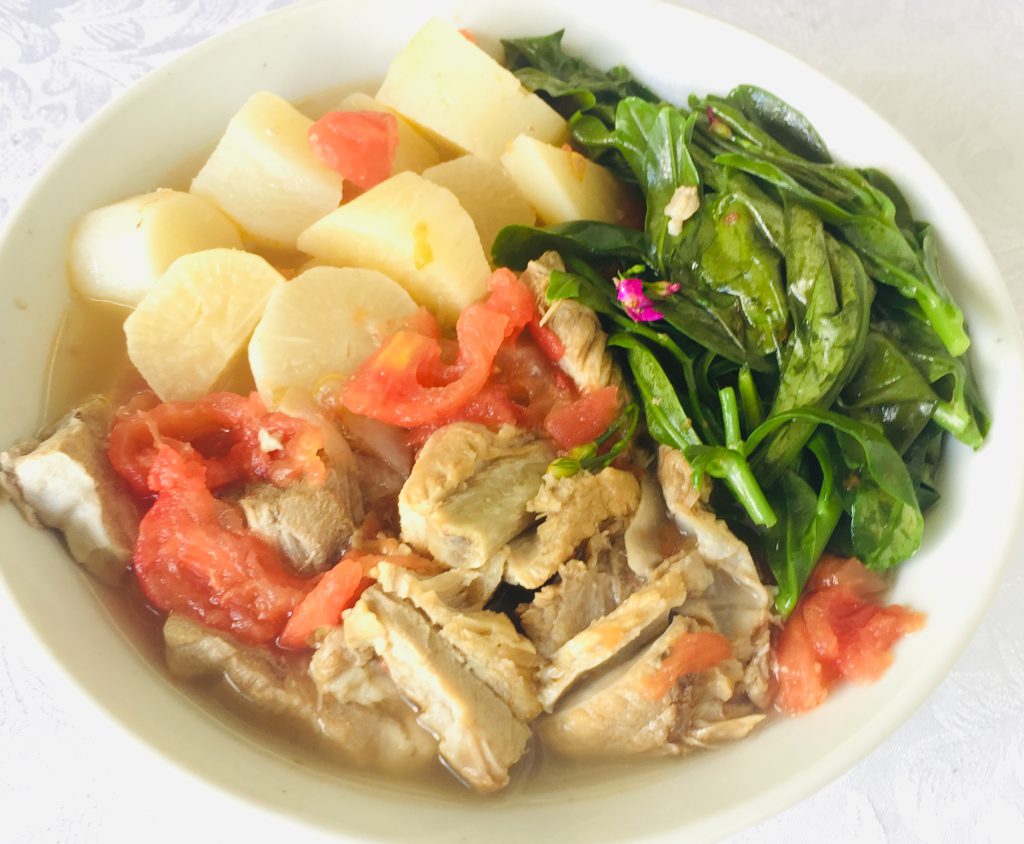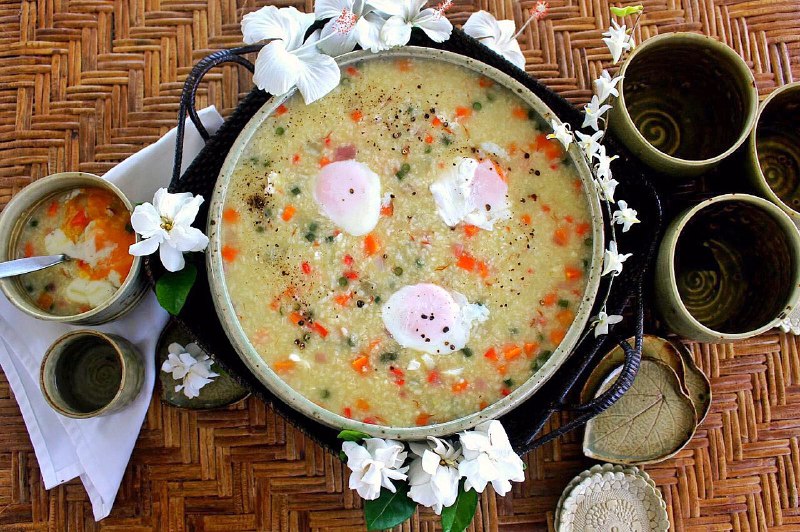
The produce has been wiped out from the grocery shelves. Either the stalls in the markets are empty, or the prices of vegetables and fruits have become exorbitant. It seems like we’re feeling the scarcity of a war, or the aftermath of a natural calamity. The extended community quarantine has made shopping for essentials more challenging. While Metro Manila residents can still enjoy the variety of meals as restaurants offer take-out and delivery, people in the provinces make the best of what’s available. Three province-based chefs bat for self-sufficiency at home and keeping the pantry well-stocked with dry goods.
Back to basics

“Lockdown cuisine is all about going back to grandmother’s cooking,” says chef-restaurateur Orvin Sayos of the Lime and Basil Thai restaurant in Alfonso, Cavite. He’s referring to an era when food was simpler and fresher.
Tagaytay and its neighboring cities are famous dining destinations. Like Metro Manila, they can still make some deliveries, but on a limited capacity.
“Markets don’t sell as much produce much as they used to. The coconut shoots for spring rolls are not available. Prices for seafood—shrimp, prawns and the basic maya-maya (red snapper), galunggong (mackerel scad) and pompano—have become steep. The materials for packing the food orders are scant. There are less vendors in the main Mahogany Market,” says Sayos. Some of his suppliers are based in neighboring towns such as Dasmariñas and Silang, which have been shut down by military checkpoints.
Like many restaurateurs, Sayos has to keep the business going with a modest menu. To provide more options, Lime and Basil recently included frozen Filipino foods such as bopis (a pork offal dish), dinuguan (pork blood stew), inasal (grilled chicken), and binagoongan (a viand with fermented shrimp paste), aside from the famous pad thai and the rice bowls of meat and basil or grilled pork with coriander sauce.
Sayos recommends stocking up on food for emergencies. “Store legumes. You can make mung bean buchi (crispy glutinous rice balls with bean filling) or soup, white beans, kidney beans. Keep foods with long shelf life such as potatoes, carrots, squash, and roof crops. Store kangkong (water spinach) in a glass jar with water so it doesn’t wilt. Other vegetables have to be chilled and dried. You never know how long this lockdown will continue. Keeping stock will be an advantage,” he says.
Sayos observes that neighbors have started to plant herbs and vegetables in their backyard. City dwellers can make use of their balconies and window sills. “Having your own herb and vegetable patch can add more flavor to your meals.”
He opts for old-fashioned recipes. On his FB page, he has posted traditional Pinoy dishes. Any beginner can make the classic bulanglang (boiled vegetable soup). His version uses hugas bigas or rice wash and available vegetables such as squash, chayote, string beans, onion, ginger, and garlic.
Creative recycling
When projects were postponed due to the lockdown, chef-consultant Cocoy Ventura hied off to the family-owned Corlyn Farms in San Mateo, Isabela. In the province, he observes that people are going back to the basics. The limited supply of LPG (liquid petroleum gas) has driven the demand for firewood. People are building wood-fire ovens.
Although the lack of available ingredients has forced people to simplify their recipes, the food has become healthier as they scrimp on fatty products and add more greens. Ventura says people are eating less meat because of their scarcity and are taking in more malunggay (moringa) because of their abundance. “The government aid has not reached the people. We are left to fend for ourselves. People have been planting in their backyards and sharing some of the harvest with neighbors.”
Given the inadequate supply of food, Ventura suggests ways to stretch the ingredients and the budget.
Living on the farm, Ventura enjoys the abundance of produce and animals. This mango season, Ventura plans to make jams and jellies. “Our fridge is small. We make preserves with a shelf life of a year or two.”
He says the family is learning to live with less. “Recycling food is about being creative,” says Ventura. The leftovers of ginataang monggo (mung bean stew with coconut milk) are given a new lease with added vegetables for dinner. For breakfast, the basic soup is prepared with a different set of vegetables and chunks of meat.
Pork can have different variations, from a straightforward sauté of garlic and onions to a medley of vegetables and tomatoes. Canned food like Spam can be jazzed up with tomato sauce, meat, potatoes and carrots. White beans are high in protein and make a healthier substitute for meat. White beans can be cooked fabada style with meat and sausages, or made into a sandwich spread. Mung bean soup can be varied with dried shrimps, meat, smoked fish, greens eggplant or bitter gourd.
Those who are lucky to receive canned goods and rice from the barangay can also make tasty meals from them. “Sardines should be served simply with calamansi and some onions, along with hot rice. Too much cooking will give that fishy taste. The instant noodles can be made into one-pot dishes. Just boil the water and add easy-to-cook vegetables,” he says.
Boosting the immune system
Chef, author, TV host, and artist Claude Tayag has one house rule: “A vegetable dish is a must to boost the immune system,” he maintains. Lockdown cuisine in his Pampanga residence means one-dish meals made in big batches, and combined with other ingredients for other meals. “Our favorite soup is boiled pork bones. We add native pechay (Chinese cabbage), tomatoes, radish and bok choy. The meat is simply a flavoring,” he says.
Then there’s the classic adobo (pork with soy sauce, vinegar and bay leaf) which has a long shelf life.
“Since it’s harder to get out of the house with this lockdown, and it takes longer to do the groceries, it’s best to store foods. You may have to use canned goods but always combine them with fresh vegetables and produce,” he says.
Tayag suggests keeping the pantry well stocked with dried mushrooms, vermicelli and egg noodles. He also favors momen (Japanese for cotton) tofu, which has a higher protein content. It lasts for a month in the fridge and is softer and firmer than native tokwa. He slices the tofu ¼ inch thick, then pan fries and flavors it with soy sauce, white wine, and ginger juice to make tofu steak. “You can make a big batch and use it for sukiyaki, chap chae or any oriental-style noodles, and as topping for fried rice,” he says.
It takes imagination to add nutritious extenders to a basic dish, thus cutting down on food costs. For instance, instead of corned beef tapsilog (meat on top of rice and fried egg), why not add lots of cabbage, tomatoes, onions, and garlic to make a serving good for six? “The corned beef merely gives the flavor and texture,” he says.
You can also Google how to make bottled tuyo (dried fish) and serve it with rice, lettuce, tomatoes, and a salad. “It’s nutritious and keeps you satisfied,” says Tayag.
Another Tayag favorite is kimchi salad. Kimchi is available in any Korean store. Add romaine lettuce, tomatoes, and Fuji apples for crispiness, and make the dressing from the kimchi dripping.
Leftovers of nilagang manok (clear chicken soup) can be recycled into a noodle dish. The broth makes a flavorful stock for noodles, while the meat can make the tasty toppings.
Tayag was well-prepared for the lockdown, In Pampanga, most residents have a mula, the Kapampangan term for kitchen garden, as exemplified in the famous folk song Bahay Kubo.
“We have everything for our daily needs from vegetables, fruits, and fowl. Apartment dwellers can plant in pots. Talinum (waterleaf) grows wild even on balconies. They are nutritious and taste like watercress. They blend well with mung bean soup,” he says. Ferns and pandan leaves grow on fences.
He advises people to cultivate root crops and bananas—staples of his grandparents during World War II. “Filipinos were self-sufficient when they planted their food in their backyard. We lost the plantings to fancy homes with gardens that aren’t practical for survival. If you have a kitchen garden, you can pick any ingredient any day of the week,’ he says.
Orvin’s Bulanglang (vegetable soup)
- 1 liter water (hugas bigas)
- 100 g patani (native lima beans)
- 1 pc red onion
- 3 pcs tomato
- 30 g ginger
- 500 g squash
- 200 g chayote
- 200 g green beans
- 1 Tbsp salt
Boil water in a pot. Add the beans and cook for 15 minutes. Add red onion, tomato, ginger, squash, and cook for another 15 minutes in low heat. Add salt, chayote, and green beans and simmer for five minutes.
Claude’s ‘Orange Soup
“Our mother made this one-meal pork soup dish with lots of tomatoes, radish, bok choy, Chinese cabbage, talinum. We call it ‘orange soup’ because of the color, although there is no fruit in it,” says Tayag.

- For 6-8 persons
- 1 kg pork—for sinigang, cut rib shoulder, or liempo (belly with ribs)
- 1 large white onion, peeled and cut into quarters
- ½ tsp whole black peppercorn
- 1 Tbsp salt
- ½ kg ripe tomatoes, washed and cut into haves
- 2 large radishes, peeled and cut into one-inch cubes
- 1 kg of any leafy vegetable
- Water
Place pork into a stockpot. Put enough water to cover the pork. Add onion, black peppercorn, tomato halves, and salt. Bring to a boil. Five minutes into the boiling, remove the tomatoes from the pot and place in a bowl of iced water. Meanwhile, put a lid and keep the pot boiling for 20 minutes or until the meat is tender. When the tomatoes are cool enough to handle, press each piece to squeeze out the pulp into a bowl. Discard the skin. Pour the tomato pulp into another bowl through a strainer. Discard the seeds while collecting the juice and pulp. Add this to the boiling pork stock. When the meat is tender, add radish cubes and continue boiling for five minutes. Add the leafy vegetables and cook for another five minutes. Adjust the seasoning according to your taste, with salt or fish sauce. Serve hot.
Cocoy’s Arroz Caldo Rapido
“Essentially, it’s leftover rice and vegetables in the fridge, seasoned with salt and vinegar and topped with eggs,” says Ventura. “This recipe is an opportunity to clean up the crisper of your fridge and use all the produce to make a wholesome dish. You’ll need one pot, no oil for sautéing. Cooking time is 15 minutes, hence ‘rapido.’ The reimagined arroz caldo is a guide to inspire creativity. Take advantage of the free products given to you by the barangay. Frugality is in, but it doesn’t have to be a drag.”

- 8 cups water
- 2 cups leftover rice or garlic fried rice
- 1 medium onion or 1 cup green onion
- 1 tsp chopped ginger
- 1 tsp safflower/kasubha for color
- 2 pcs bay leaves
- 4 eggs
- 3 Tbsp vinegar
Salt and pepper to taste
2 handfuls of any vegetable (suggestions: 1 small, diced sweet potato, 1 small diced taro, 1 small diced carrot, 1 small diced bell pepper, 3 strands of long beans cut into pieces. You may also use squash, chayote, green papaya, or any roughage)
In a large pot, bring rice, kasubha, and water to a boil. Add more water if rice is absorbing the liquid quickly. When the rice kernels burst, add bay leaves and mix in all the vegetables. Stir and cover for three minutes and lower the heat. Add vinegar and season with salt and pepper. Crack the eggs on top of the porridge, but don’t stir. Put back the lid and turn off the heat. Serve in five minutes.






































